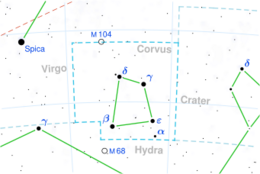Astronomy:Zeta Corvi
| Observation data Equinox J2000.0]] (ICRS) | |
|---|---|
| Constellation | Corvus |
| Right ascension | 12h 20m 33.64200s[1] |
| Declination | −22° 12′ 57.2410″[1] |
| Apparent magnitude (V) | 5.21[2] |
| Characteristics | |
| Evolutionary stage | Be star |
| Spectral type | B8V[3] |
| U−B color index | −0.39[4] |
| B−V color index | −0.11[4] |
| Astrometry | |
| Radial velocity (Rv) | −6.40 ± 4.2[2] km/s |
| Proper motion (μ) | RA: −108.97[1] mas/yr Dec.: −27.31[1] mas/yr |
| Parallax (π) | 7.85 ± 0.22[1] mas |
| Distance | 420 ± 10 ly (127 ± 4 pc) |
| Absolute magnitude (MV) | −0.32[5] |
| Details | |
| Mass | 3.39±0.04[6] M☉ |
| Radius | 4.57±0.09[7] R☉ |
| Luminosity | 200[6] L☉ |
| Surface gravity (log g) | 2.26±0.02[7] cgs |
| Temperature | 11,561[6] K |
| Rotational velocity (v sin i) | 259[6] km/s |
| Other designations | |
| Database references | |
| SIMBAD | data |
Zeta Corvi, Latinised from ζ Corvi, is a star in the constellation Corvus. It is a blue-white main-sequence star of apparent magnitude 5.21. Around 420 light-years distant, it shines with a luminosity approximately 154 times that of the Sun and has a surface temperature of 10,695 K.[8] It is a Be star, the presence of hydrogen emission lines in its spectrum indicating it has a circumstellar disk. It is separated by 7 arcminutes from the star HR 4691. The two may be an optical double or a true multiple star system, with a separation of at least 50,000 astronomical units and the stars taking 3.5 million years to orbit each other. HR 4691 is itself double, composed of an ageing yellow-orange giant whose spectral type has been calculated at K0 or G3, and an F-type main-sequence star.[9]
References
- ↑ 1.0 1.1 1.2 1.3 1.4 van Leeuwen, F. (2007). "Validation of the new Hipparcos reduction". Astronomy and Astrophysics 474 (2): 653–664. doi:10.1051/0004-6361:20078357. Bibcode: 2007A&A...474..653V. http://www.aanda.org/index.php?option=com_article&access=bibcode&Itemid=129&bibcode=2007A%2526A...474..653VFUL.
- ↑ 2.0 2.1 "zet+Crv". SIMBAD. Centre de données astronomiques de Strasbourg. http://simbad.u-strasbg.fr/simbad/sim-basic?Ident=zet%2BCrv.
- ↑ Strom, Stephen E.; Wolff, Sidney C.; Dror, David H. A. (2005). "B Star Rotational Velocities in h and χ Persei: A Probe of Initial Conditions during the Star Formation Epoch?". The Astronomical Journal 129 (2): 809–828. doi:10.1086/426748. Bibcode: 2005AJ....129..809S.
- ↑ 4.0 4.1 Mermilliod, J.-C. (1986). "Compilation of Eggen's UBV data, transformed to UBV (unpublished)". Catalogue of Eggen's UBV Data., 0 (1986): 0. Bibcode: 1986EgUBV........0M. http://cdsads.u-strasbg.fr/cgi-bin/nph-bib_query?1986EgUBV........0M&db_key=AST&nosetcookie=1.
- ↑ Anderson, E.; Francis, Ch. (2012), "XHIP: An extended hipparcos compilation", Astronomy Letters 38 (5): 331, doi:10.1134/S1063773712050015, Bibcode: 2012AstL...38..331A.
- ↑ 6.0 6.1 6.2 6.3 Zorec, J.; Royer, F.; Dror, David (2012). "Rotational velocities of A-type stars. IV. Evolution of rotational velocities". Astronomy and Astrophysics 537: A120. doi:10.1051/0004-6361/201117691. Bibcode: 2012A&A...537A.120Z.
- ↑ 7.0 7.1 Arcos, C.; Kanaan, S.; Chávez, J.; Vanzi, L.; Araya, I.; Curé, M. (2018). "Stellar parameters and H α line profile variability of be stars in the BeSOS survey". Monthly Notices of the Royal Astronomical Society 474 (4): 5287. doi:10.1093/mnras/stx3075. Bibcode: 2018MNRAS.474.5287A.
- ↑ McDonald, I.; Zijlstra, A. A.; Boyer, M. L. (2012). "Fundamental Parameters and Infrared Excesses of Hipparcos Stars". Monthly Notices of the Royal Astronomical Society 427 (1): 343–57. doi:10.1111/j.1365-2966.2012.21873.x. Bibcode: 2012MNRAS.427..343M.
- ↑ Kaler, James B. (Jim) (26 April 2013), "Zeta Corvi", Stars (University of Illinois), http://stars.astro.illinois.edu/sow/zetacrv.html, retrieved 18 March 2015
 |


